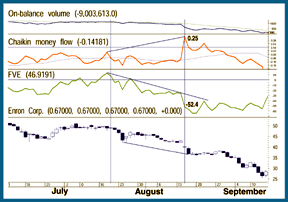INDICATORS
Sink Or Swim
Detecting Breakouts
by Markos Katsanos
The finite volume elements (FVE) indicator is yet another money flow indicator -- but it takes into account both intra- and interday price action.
Most technical analysts underestimate volume indicators in favor of price-based indicators or price pattern recognition. Volume often leads price, and volume indicators can predict this price change by observing the delicate balance of supply and demand in the never-ending battle between buyers and sellers, bulls and bears. To help analyze crowd psychology and profit from subsequent price moves, I created the finite volume elements (FVE) indicator.
VOLUME-BASED INDICATORS
Money flow, accumulation/distribution, and balance of power are all terms synonymous with volume-based indicators. I have been using volume indicators for some time as my prime tools in making trading decisions, and I've found that divergences between volume and price are often the only clues to important reversals.
Volume indicators use intraday (the relation of the close to the midpoint of the day) or interday (today's price relative to yesterday's) price action to calculate whether money is flowing in or out of a security. The best-known intraday money flow indicators include Marc Chaikin's money flow index (CMF), David Bostian's intraday intensity, and Williams' accumulation/distribution. These all ignore the stock's price change relative to the past, but calculate accumulation or distribution according to the relation between the closing price and the midpoint (Chaikin and Bostian) or the open (Williams) of the day.
On the other hand, the best-known money flow indicators that use interday price changes are on-balance volume (OBV), David Markstein's volume-price trend, and the money flow index (MFI), which is a volume-weighted relative strength index (RSI).

FIGURE 1: ENRON CORP. (NYSE:ENE). First window from bottom: 21-day FVE. Second window from bottom: 21-day CMF. Top window: OBV.
...Continued in the April 2003 issue of Technical Analysis of STOCKS & COMMODITIES
Excerpted from an article originally published in the April 2003 issue of Technical Analysis of STOCKS & COMMODITIES magazine. All rights reserved. © Copyright 2003, Technical Analysis, Inc.
Return to April 2003 Contents